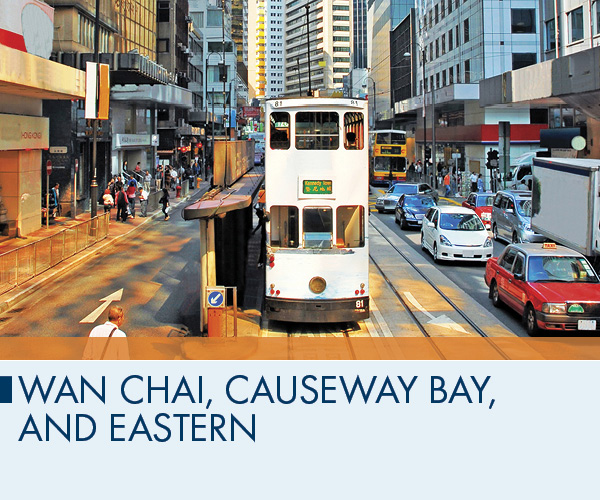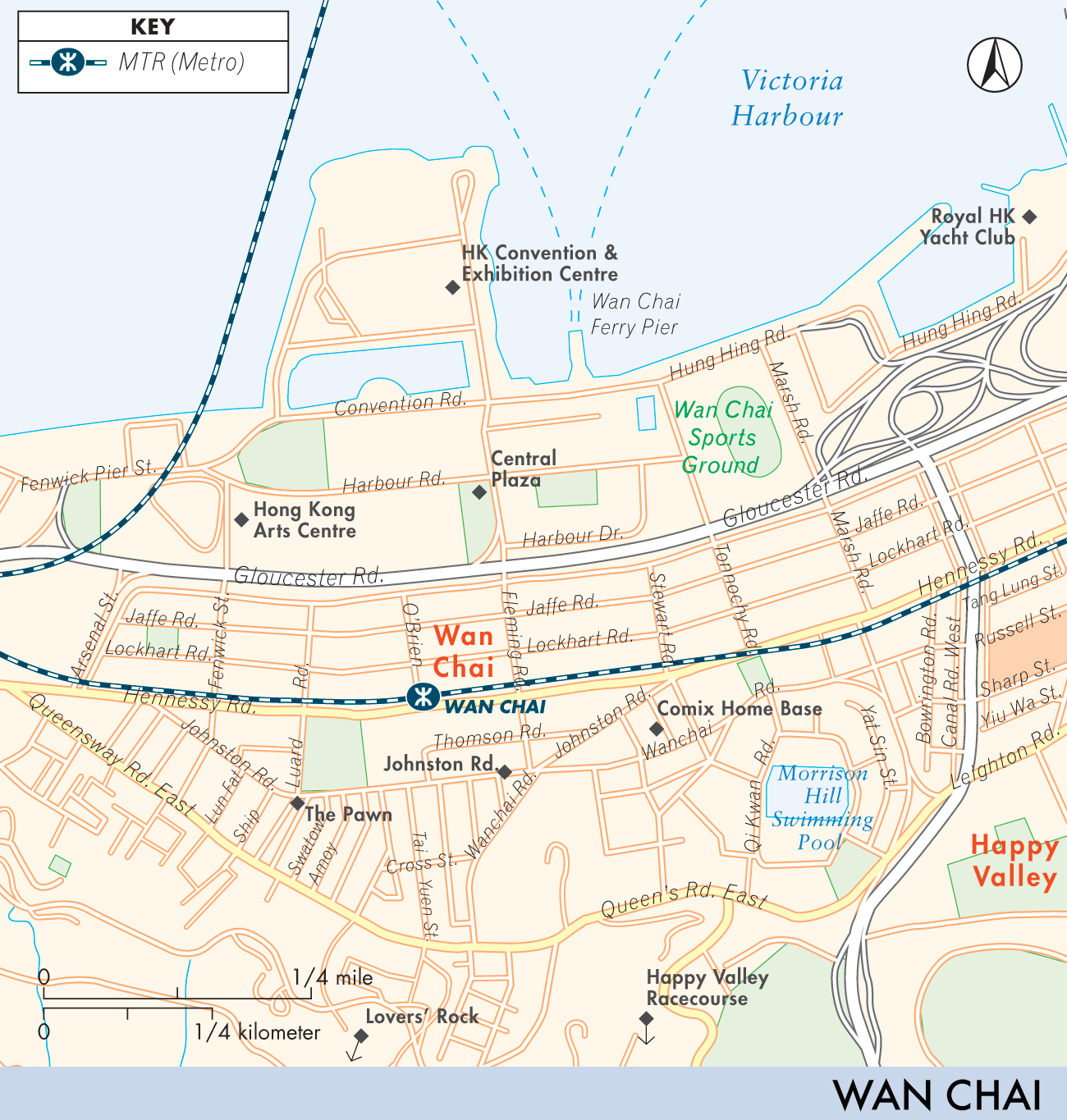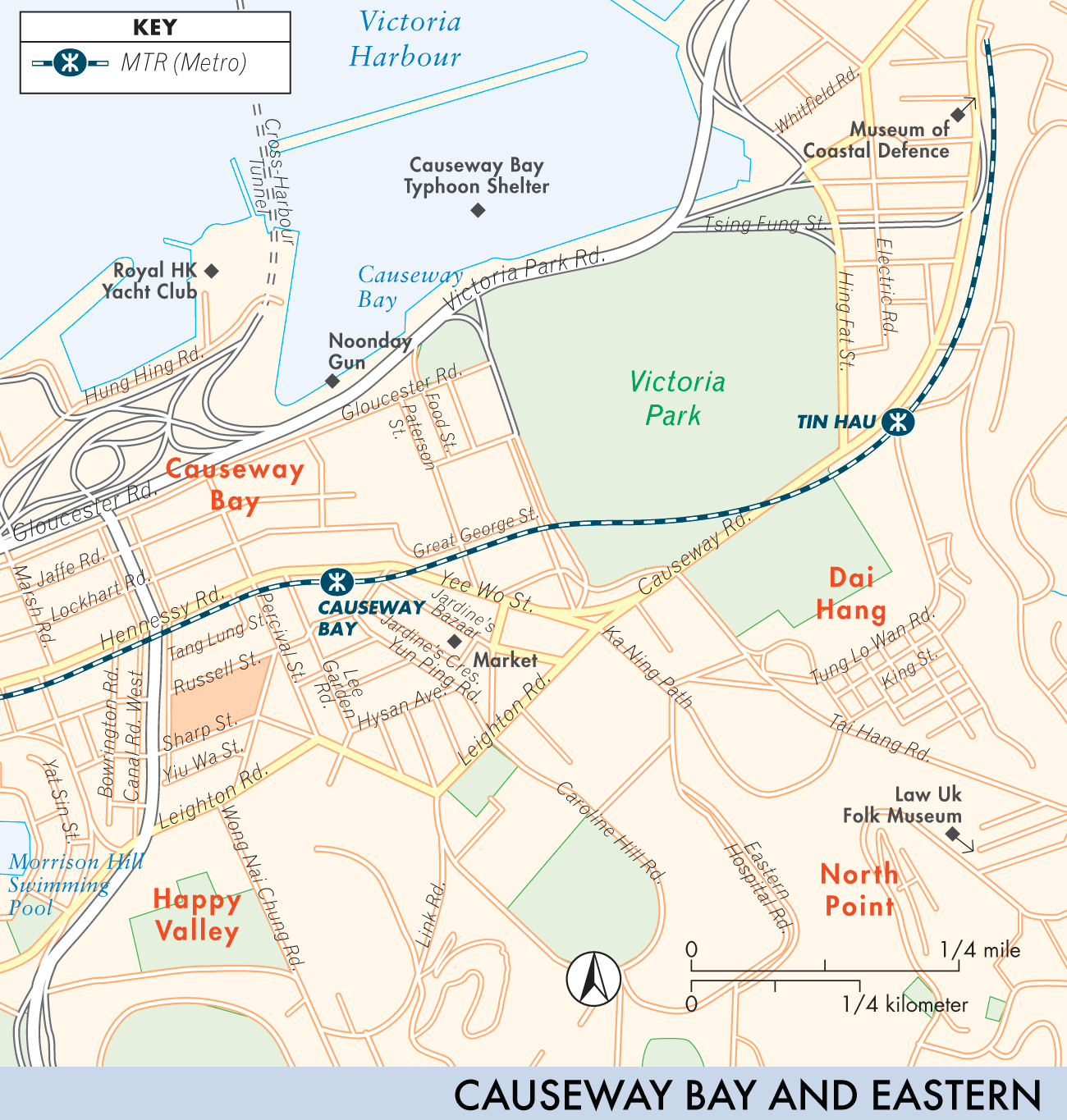Previous Chapter | Next Chapter | Table of Contents
Wan Chai | Causeway Bay | Eastern
Explore beyond Western and Central and you’ll discover that Wan Chai, Causeway Bay, Happy Valley, and the neighborhoods of the Eastern District are equally as vibrant—revealing another facet of Hong Kong. Though Wan Chai is known primarily for its nightlife (think raunchy entertainment and rowdy expats), it is also home to the Convention Centre, beautiful colonial buildings, and a handful of arts institutions. Causeway Bay, one of the city’s liveliest areas, is a shopping and dining mecca, and the Happy Valley horse races, a big part of Hong Kong life, are just a short walk away.
THE TERRITORY
Wan Chai’s trams run mostly along Hennessy Road, with a detour along Johnston Road at the neighborhood’s western end. Queen’s Road East runs parallel to these two streets to the south, and a maze of lanes connects it with Hennessy.
The thoroughfares north of Hennessy—Lockhart, Jaffe, and Gloucester, which is a freeway—are laid out in a grid. Causeway Bay’s diagonal roads make the neighborhood hard to navigate, but it’s small; wander around and before long you’ll hit something familiar.
TAKING IT IN
Once Upon a Time in the East. There were settlements here long before the British arrived, and the area was strategically important after colonization. Find out about it all from local historian Jason Wordie (www.jasonswalks.com), who runs tours through Wan Chai, Causeway Bay, Shau Kei Wan, Central, and beyond.
A Wan Chai Wander. Rattle to Wan Chai by tram along roads dense with jutting signs. Get off at Southorn Playground, and wander the lanes south of Johnston Road before heading up Luard Road and over walkways to the Hong Kong Academy for Performing Arts and Hong Kong Arts Centre, in adjacent buildings. The Hong Kong Convention and Exhibition Centre is a few minutes away—wander its harborside promenade. If you’re here at dusk, Wan Chai’s drinking holes will be lighting up as you walk back to the MTR along Fleming Road. Look up at Central Plaza on your right.
QUICK BITES
Butchers Club Burgers.
With hands-down the best burgers in Hong Kong, Butchers Club Burgers is run by an affable bunch who are serious about their minced-to-order bacon cheeseburgers and duck-fat fries. | Ground fl., Rialto Bldg.,2 Landale St., Wan Chai | 2528–2083 | www.butchersclub.com.hk.
The Flying Pan.
In a nightspot-packed district, a café serving breakfast round-the-clock is bound to be a hit. The Flying Pan’s Wan Chai branch has 19 different types of omelets, waffles, blintzes, grilled sandwiches—the list goes on. This is the perfect spot to hit after barhopping. | 3rd fl.,81–85 Lockhart Rd., Wan Chai |2528–9997 | www.the-flying-pan.com.
Yee Shun Milk Company.
Yee Shun Milk Company sounds kooky, but you can’t leave Causeway Bay without dessert at this crowded little diner. The signature dish is steamed milk pudding with ginger juice. | 506 Lockhart Rd., Causeway Bay | 2591–1837.
GETTING AROUND
Both Wan Chai and Causeway Bay have their own MTR stops, but a pleasant way to arrive from Central is on the tram along Hennessy Road. If you’re going beyond Wan Chai, check the sign at the front: some continue to North Point and Shau Kei Wan, via Causeway Bay, while others go south to Happy Valley.
The underground MTR stations are small labyrinths, so read the signs carefully to find the best exit. Traffic begins to take its toll on journey times to places beyond Causeway Bay, and the MTR is often the quickest way to travel.
WAN CHAI
All in all, Hong Kong’s notorious center of lowlife is fairly tame these days, with a bustling mix of hotels, shops, and convention facilities. This doesn’t mean that the old neighborhood has lost all its character. A few blocks back from Wan Chai’s new office blocks are crowded alleys where you can still experience old Hong Kong and stumble across a wet market, a tiny furniture-maker’s shop, an age-old temple, and yes, the strip joints, dive bars, and gambling dens that have long made the quarter popular with denizens of the night. Like all of Hong Kong, Wan Chai is quite safe after dark, but single women strolling the streets in the wee hours might get unwanted attention from groups of drunken tourists.
TOP ATTRACTIONS
Hong Kong Arts Centre.
The 19-story Hong Kong Arts Centre houses a branch of the Hong Kong Art School, several contemporary art galleries, interactive workshops, multimedia installations, art studios, a cinema, and performing arts venues. There are also a handful of eateries. The art hub has long been a champion of up-and-coming artists, and its latest project is Comix Home Base on nearby Mallory Street. There are free guided tours every Wednesday and Saturday at 3 pm, lasting about 45 minutes. | 2 Harbour Rd., Wan Chai | 2582–0200 | www.hkac.org.hk | Free | Daily 8 am–11 pm | Station: Wan Chai, Exit C.
WORTH NOTING
Central Plaza.
Clad in reflective gold, silver, and copper-colored glass, this triangular building is glitzy to the point of tastelessness. In 1992 it was briefly the city’s tallest building, but Two IFC soon beat it by 130 feet. Note the colorful fluorescent lights atop the building; they actually are a clock so complicated that no one knows how to tell time using it. | 18 Harbour Rd., Wan Chai | 2586–8111 | www.centralplaza.com.hk.
Comix Home Base.
Devoted to the creative and quirky world of comics and animation, this center celebrates local artists by offering up ample space to create, exhibit, and sell their work. The complex is also a great example of Hong Kong’s historic East-meets-West architecture, as it’s housed in a cluster of revitalized prewar tenement-style buildings with cantilevered balconies, high ceilings, and staircases made of China fir wood. | 7 Mallory St., Wan Chai | 2824–5303 |www.comixhomebase.com.hk | Daily 10–8.
Hong Kong Convention and Exhibition Centre.
Land is so scarce in Hong Kong that developers usually only build skyward, but the HKCEC juts into the harbor instead. Curved-glass walls and a swooping roof make it look like a tortoise lumbering into the sea or a gull taking flight, depending on who you ask. Of all the international trade fairs, regional conferences, and other events held here, by far the most famous was the 1997 Handover Ceremony. An obelisk commemorates it on the waterfront promenade, which also affords great views of Kowloon.
Outside the center stands the Golden Bauhinia. This gleaming sculpture of the bauhinia flower, Hong Kong’s symbol, was a gift from China. The police hoist the flag daily at 7:50 am; on the first of every month, there is an enhanced flag-raising ceremony with musical accompaniment at 7:45 am. | 1 Expo Dr.,Wan Chai | 2582–8888 | www.hkcec.com.hk | Station: Wan Chai, Exit A.
Johnston Road.
Trams clatter along this busy road, which is choked with traffic day and night. It’s also packed with shops selling food, cell phones, herbal tonics, and bargain-basement clothes. Rattan furniture, picture frames, paper lanterns, and Chinese calligraphic materials make up the more traditional assortment at Queen’s Road East, which runs parallel to Johnston Road. The lanes that stretch between the two roads are also lined with stalls, forming a mini-market of clothing and accessories. | Johnston Rd., between Heard and Gresson Sts., Wan Chai | Station: Wan Chai, Exit A3.
Lovers’ Rock.
High above Wan Chai sits the suggestively shaped monolith known as Lovers’ Rock, or Yan Yuen Shek. It’s a frequent destination among local single women, who burn joss sticks and make offerings in hope of finding a husband. Not in the market? The walk along Bowen Road offers excellent views over the city, particularly at dusk. The easiest way up is on Minibus 24A from the Admiralty MTR station. | Bowen Rd., between Wan Chai Gap and Stubbs Rds., Wan Chai.
DID YOU KNOW?: Wan Chai was once one of the five wan—areas the British set aside for Chinese residences—but it developed a reputation for vice and attracted sailors on shore leave during the Vietnam War. How times have changed: Wan Chai is still as risqué an area as Hong Kong has to offer, but that says more about the city’s overall respectability than it does about the available indulgences. For all its bars and massage parlors, Wan Chai is now so safe that it seems a pale version of the “Wanch” of Richard Mason’s novel The World of Suzie Wong. Today many venture to the area for arts and culture at the Hong Kong Academy for Performing Arts and the Hong Kong Arts Centre.
CAUSEWAY BAY
Shoppers crowd the streets of Causeway Bay, the area east of Wan Chai, seven days a week. The action happens within a five-block radius of the intersection of Hennessy Road and Percival Street, where you’ll find pockets of mazelike malls full of clothing, jewelry, and gadgets. There are also lots of restaurants in the area, as well as upstairs cafés (inside commercial and residential buildings) that are often populated by teens and twentysomethings.
TOP ATTRACTIONS
Fodor’s Choice | Happy Valley Racecourse.
The biggest attraction east of Causeway Bay for locals and visitors alike is this local legend, where millions of Hong Kong dollars make their way each year. The exhilarating blur of galloping hooves under jockeys dressed in bright silk jerseys is a must-see. The races make great Wednesday nights out on the town. Aside from the excitement of the races, there are restaurants, bars, and even a racing museum to keep you amused. The public entrance to the track is a 20-minute walk from Causeway Bay MTR Exit A (Times Square), or simply hop on the Happy Valley tram, which terminates right in front. | Sports Rd. at Wong Nai Chung Rd., Happy Valley, Causeway Bay | HK$10 | Wed. 6–11:30 pm during racing season | Station: Causeway Bay, Exit A.
Victoria Park.
Hong Kong Island’s largest park is a welcome breathing space on the edge of Causeway Bay. It’s beautifully landscaped and has recreational facilities for soccer, basketball, swimming, lawn bowling, and tennis. At dawn every morning hundreds practice tai chi chuan here. During the Mid-Autumn Festival it’s home to the Lantern Carnival, when the trees are a mass of colorful lights. Just before Chinese New Year (late January to early February), the park hosts a huge flower market. On the eve of Chinese New Year, after a traditional family dinner at home, much of Hong Kong happily gathers here to shop and wander into the early hours of the first day of the new year. | 1 Hing Fat St., Causeway Bay | 2890–5824 | www.lcsd.gov.hk | Free | 24 hours | Station:Tin Hau, Exit A2.
WORTH NOTING
Causeway Bay Typhoon Shelter.
Hong Kong’s maritime past and present are much in evidence on Causeway Bay’s waterfront. Beginning in 1883, those who lived on sampans and old-fashioned junks gathered during bad weather in the Causeway Bay Typhoon Shelter, the first of its kind in the city. Most boat-dwellers have moved to dry land, so these days yachts and speedboats moor here. A few traditional sampans, crewed primarily by elderly women, still ferry owners to their sailboats. |Near entrance of Cross Harbour Tunnel, Causeway Bay | Station: Causeway Bay, Exit D1.
Noonday Gun.
A block east of the Royal Hong Kong Yacht Club stands the Noonday Gun, which Noël Coward made famous in his song Mad Dogs and Englishmen. It’s still fired by a Jardine Matheson employee at noon every day. It is said that the tradition began when a Jardine employee fired a gun in salute of the company’s head arriving at the port, angering an officer of the Royal Navy. | Victoria Park Rd., Causeway Bay | Station: Causeway Bay, Exit D1.
DID YOU KNOW?: Opium-smuggler-turned-investment-bank Jardine Matheson once had its warehouses in Causeway Bay. The company moved to Central decades ago, but left a legacy of street names: there’s Jardine’s Bazaar and Jardine’s Crescent, two of Causeway Bay’s best shopping streets, and Yee Wo Street with the firm’s Chinese name.
EASTERN
The densely populated neighborhoods east of Causeway Bay are largely residential and commercial, with a good number of shopping malls and restaurants that cater to residents. You’ll also find art galleries and bookshops installed in converted industrial buildings, and some fascinating museums that are well worth seeking out.
TOP ATTRACTIONS
Law Uk Folk Museum.
This restored Hakka house was once the home of the Law family, who arrived here from Guangdong in the mid-18th century. It’s the perfect example of a triple-jian, double-lang residence. Jian are enclosed rooms—here, the bedroom, living room, and workroom at the back. The front storeroom and kitchen are the lang, where the walls don’t reach up to the roof, and thus allow air in. Although the museum is small, informative texts outside and displays of rural furniture and farm implements inside give a powerful idea of what rural Hong Kong was like. It’s definitely worth a trip to bustling industrial Chai Wan, at the eastern end of the MTR, to see it. Photos show what the area looked like in the 1930s—these days a leafy square is the only reminder of the woodlands and fields that once surrounded this buttermilk-color dwelling. | 14 Kut Shing St., Chai Wan, Eastern | 2896–7006 | www.lcsd.gov.hk | Free | Fri.–Wed. 10–6 | Station: Chai Wan, Exit B.
WORTH NOTING
FAMILY | Museum of Coastal Defence.
The Lei Yue Mun Fort makes for an appropriate home for the Museum of Coastal Defence. The museum is in the redoubt, a high area of land overlooking the narrowest point of the harbor; you take an elevator and cross an aerial walkway to reach it. As well as the fascinating historical displays indoors, there’s a historical trail complete with tunnels, cannons, and observation posts. | 175 Tung Hei Rd., Shau Ki Wan, Eastern | 2569–1500 |hk.coastaldefence.museum | HK$10; free Wed. | Fri.–Wed. 10–5 | Station: Shau Ki Wan, Exit B2.


